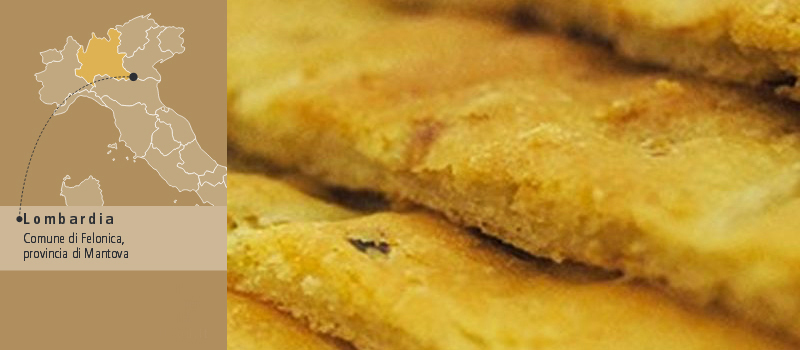
The Slow Food Presidia project was created to safeguard small-scale producers and protect traditional, high-quality products. www.fondazioneslowfood.com
Tiròt is the Mantuan dialect word for a typical focaccia historically produced in Felonica, a small town in the “bassa mantovana”. This is the name of the south-east area of the province of Mantova where Emilia-Romagna, Lombardia and Veneto meet, a hundred miles away from the Po Delta. Tiròt has such deep roots in this region that the village festival, which takes place in mid-August, is entirely dedicated to it. This focaccia was traditionally eaten while working in the fields or in the evening, when the family gathered together in the farmyard. Women used to prepare the dough early in the morning by mixing soft wheat flour, onion, lard, yeast, salt and water; then they took it to the village furnace, from which an intense but pleasant onion smell spreaded across the streets of Felonica.
The recipe was already mentioned in the 1827 Italian-Mantuan dictionary by Francesco Cherubini.
The name Tiròt comes from the first phase of this product’s manual processing, when the dough, soft and sticky, is stretched (“tirata” in Italian) on a baking tray; after that, it needs some time to rise before baking. This straw-yellow focaccia is traditionally cut in a rectangular shape and is a few millimetres thick.
The cultivation of the sweet golden Felonica onion is almost extinct in the Oltrepò mantovano, since nowadays many different types of hybrid crops are grown in that area.
Among the main reasons for this choice are the drop in prices in the national market and the peculiarities of this onion bulb, which limit the storage period to 90 days instead of 1-2 years.
The massive onion cultivation in Felonica dates back to XIX century; in particular, yellow onion has been the major source of income for a long time. After WWII, all the members of local families – children, elderly people, farmers, even workers and clerks – were involved in onion cultivation, as they leased their small fields to round up their income.
Warehouses were built, a factory that produced wooden boxes was founded and onions were sent abroad by train, mainly in France, Germany and Sweden. But onion production plunged into crisis by the end of the 70s (the last warehouse was closed about 30 years ago) and, consequently, tiròt production became limited, family traditions slowly declined and the old village furnaces had to close down.
Luckily, some rasdore (“cooks” in local dialect) capable of handing down the secrets this unique product still exist. In the meantime, tiròt caught the attention of Slow Food and entered the “Slow Food Presidia project”. Note that this gastronomic speciality is also included in the Ministry for Agricultural, Food and Forestry policies’ list of the traditional products of Lombardy.
In short, a single and particular gesture belonging to the country tradition has transformed over time into an authentic rite. For a long time, tiròt has been consumed by peasants after onion harvesting, in a moment of collective joy; nowadays, it’s highly appreciated by whoever is looking for unspoiled flavours and traditions.
The recipe was already mentioned in the 1827 Italian-Mantuan dictionary by Francesco Cherubini.
The name Tiròt comes from the first phase of this product’s manual processing, when the dough, soft and sticky, is stretched (“tirata” in Italian) on a baking tray; after that, it needs some time to rise before baking. This straw-yellow focaccia is traditionally cut in a rectangular shape and is a few millimetres thick.
The cultivation of the sweet golden Felonica onion is almost extinct in the Oltrepò mantovano, since nowadays many different types of hybrid crops are grown in that area.
Among the main reasons for this choice are the drop in prices in the national market and the peculiarities of this onion bulb, which limit the storage period to 90 days instead of 1-2 years.
The massive onion cultivation in Felonica dates back to XIX century; in particular, yellow onion has been the major source of income for a long time. After WWII, all the members of local families – children, elderly people, farmers, even workers and clerks – were involved in onion cultivation, as they leased their small fields to round up their income.
Warehouses were built, a factory that produced wooden boxes was founded and onions were sent abroad by train, mainly in France, Germany and Sweden. But onion production plunged into crisis by the end of the 70s (the last warehouse was closed about 30 years ago) and, consequently, tiròt production became limited, family traditions slowly declined and the old village furnaces had to close down.
Luckily, some rasdore (“cooks” in local dialect) capable of handing down the secrets this unique product still exist. In the meantime, tiròt caught the attention of Slow Food and entered the “Slow Food Presidia project”. Note that this gastronomic speciality is also included in the Ministry for Agricultural, Food and Forestry policies’ list of the traditional products of Lombardy.
In short, a single and particular gesture belonging to the country tradition has transformed over time into an authentic rite. For a long time, tiròt has been consumed by peasants after onion harvesting, in a moment of collective joy; nowadays, it’s highly appreciated by whoever is looking for unspoiled flavours and traditions.
Leave A Comment